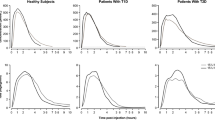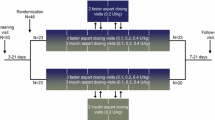Abstract
Introduction
Small peptides are approved as treatments for type 2 diabetes mellitus and may have utility in metabolic diseases. These peptides often have short half-lives requiring delivery either as a sustained-release formulation or via a device. The opportunity to study their pharmacokinetics using simple solution formulations delivered by continuous subcutaneous infusion may facilitate the drug development process.
Methods
Here, we investigated the systemic exposure of an exemplar peptide (exenatide) when infused in healthy subjects using a Paradigm® Revel™ insulin infusion pump (Medtronic MiniMed). Four infusion regimens were tested: Constant 24-h infusion (16.5 μg/day), constant 7-day infusion (25.5 μg/day in Cohort 2), and two different 7-day escalation regimens (ranging from 7 to 58.5 μg/day in Cohort 1 and 25.5–58.5 μg/day in Cohort 3).
Results
While the overall exenatide pharmacokinetics were in line with those expected, the observed within-subject concentration variability was considerable.
Conclusion
Our work identifies sources of potential pharmacokinetic variability relating to the method of delivery and the drug’s formulation that will be valuable to investigators contemplating the delivery of peptides via insulin infusion pumps.
Funding
GlaxoSmithKline.
Trial registration: ClinicalTrials.gov number, NCT01857895.




Similar content being viewed by others
References
Vlieghe P, Lisowski V, Martinez J, Khrestchatisky M. Synthetic therapeutic peptides: science and market. Drug Discov Today. 2010;15:40–56.
Yulyaningsih E, Zhang L, Herzog H, Sainsbury A. NPY receptors as potential targets for anti-obesity drug development. Br J Pharmacol. 2011;163:1170–202.
Diao L, Meibohm B. Pharmacokinetics and Pharmacokinetic-Pharmacodynamic Correlations of Therapeutic Peptides. Clin Pharmacokinet. 2013;52:855–68.
Nauck MA. GLP-1 for the treatment of type 2 diabetes. Horm Metab Res. 2004;36:852–8.
De Silva A, Salem V, Long CJ, et al. The gut hormones PYY3–36 and GLP-17–36 amide reduce food intake and modulate brain activity in appetite centers in humans. Cell Metab. 2011;14:1–7.
Nielsen LL, Young AA, Parkes DG. Pharmacology of exenatide (synthetic exendin-4): a potential therapeutic for improved glycemic control of type 2 diabetes. Regul Pept. 2004;117:77–88.
Gedulin BR, Nikoulina SE, Smith PA, et al. Exenatide (exendin-4) improves insulin sensitivity and b-cell mass in insulin-resistant obese fa/fa Zucker rats independent of glycemia and body weight. Endocrinology. 2005;146:2069–76.
Fehse F, Trautmann M, Holst JJ, et al. Exenatide augments first and second phase insulin secretion in response to intravenous glucose in subjects with type 2 diabetes. J Clin Endocrinol Metab. 2005;90:5991–7.
DeFronzo RA, Ratner R, Han J, Kim DD, Fineman MS, Baron AD. Effect of exenatide (exendin-4) on glycemic control and weight over 30 weeks in metformin-treated patients with type 2 diabetes. Diabetes Care. 2005;28:1092–100.
Kendall DM, Riddle MC, Rosenstock J, et al. Effects of exenatide (exendin-4) on glycemic control over 30 weeks in patients with type 2 diabetes treated with metformin and a sulfonylurea. Diabetes Care. 2005;28:1083–91.
Taylor K, Kim D, Nielsen LL, Aisporna M, Baron AD, Fineman MS. Day-long subcutaneous infusion of exenatide lowers glycemia in patients with type 2 diabetes. Horm Metab Res. 2005;37:627–32.
Henry RR, Rosenstock J, Logan DK, Alessi TR, Luskey K, Baron MA. Randomized trial of continuous subcutaneous delivery of exenatide by ITCA 650 versus twice-daily exenatide injections in metformin-treated type 2 diabetes. Diabetes Care. 2013;36:2559–65.
Henry RR, Rosenstock J, Logan D, et al. Continuous subcutaneous delivery of exenatide via ITCA 650 leads to sustained glycemic control and weight loss for 48 weeks in metformin-treated subjects with type 2 diabetes. J Diabetes Complicat. 2014;28(3):393–8.
Bydureon Package Insert. https://www.bydureon.com/. Accessed 20 June 2015.
Byetta Package Insert. https://www.byetta.com/. Accessed 20 June 2015.
Acknowledgments
This study (ClinicalTrials.gov number, NCT01857895) and the article processing charges associated with this publication have been sponsored by GlaxoSmithKline. We thank the investigator and subjects who participated in the study and Rebecca Hodge, Ella Kersey, Malcolm Young, and Steve Stagliano (Medtronic Inc.) for their valuable input. All named authors meet the International Committee of Medical Journal Editors (ICMJE) criteria for authorship for this manuscript, take responsibility for the integrity of the work as a whole, and have given final approval for the version to be published.
Conflict of interest
Georgios Vlasakakis was an employee of GlaxoSmithKline at the time of this publication and has/had stock/stock options in the company. Susan L. Johnson was an employee of GlaxoSmithKline at the time of this publication and has/had stock/stock options in the company. Jiang Lin was an employee of GlaxoSmithKline at the time of this publication and has/had stock/stock options in the company. Xiaozhou Yao was an employee of GlaxoSmithKline at the time of this publication and has/had stock/stock options in the company. Christopher J. Gruenloh was an employee of GlaxoSmithKline at the time of this publication and has/had stock/stock options in the company. John P. Chism was an employee of GlaxoSmithKline at the time of this publication and has/had stock/stock options in the company. Derek J. Nunez was an employee of GlaxoSmithKline at the time of this publication and has/had stock/stock options in the company.
Compliance with ethics guidelines
The study protocol and one amendment, the informed consent, and other relevant information were reviewed and approved by a GlaxoSmithKline protocol review group and an institutional review board (Aspireirb, 11491 Woodside Ave, Santee, CA 92071), in accordance with the International Conference on Harmonization Good Clinical Practice guidelines and the principles of the Declaration of Helsinki. Written informed consent was obtained from each subject prior to the performance of any study-specific procedures.
Author information
Authors and Affiliations
Corresponding author
Electronic supplementary material
Below is the link to the electronic supplementary material.
Rights and permissions
About this article
Cite this article
Vlasakakis, G., Johnson, S.L., Lin, J. et al. Pharmacokinetics and Tolerability of Exenatide Delivered by 7-Day Continuous Subcutaneous Infusion in Healthy Volunteers. Adv Ther 32, 650–661 (2015). https://doi.org/10.1007/s12325-015-0222-4
Received:
Published:
Issue Date:
DOI: https://doi.org/10.1007/s12325-015-0222-4




